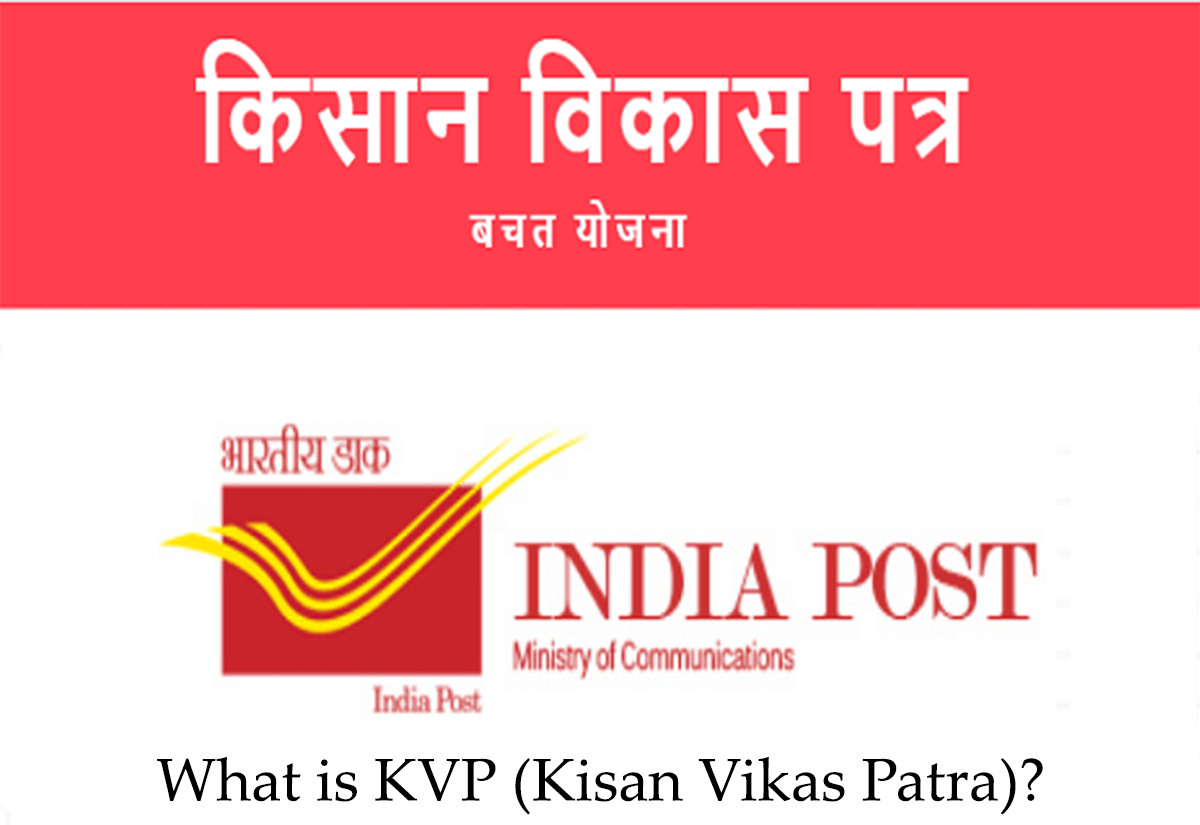What's Inside?
- What is KVP (Kisan Vikas Patra)?
- Benefits of KVP (Kisan Vikas Patra)
- How to open KVP (Kisan Vikas Patra) account?
- Who is eligible for KVP (Kisan Vikas Patra)?
- What is the process for withdrawing funds from a Kisan Vikas Patra (KVP) account upon maturity?
- Transfer of KVP (Kisan Vikas Patra) Certificate
- KVP (Kisan Vikas Patra) premature closure/early withdrawal
- Disadvantages of KVP (Kisan Vikas Patra)
What is KVP (Kisan Vikas Patra)?
In 1988, the Indian Post Office launched a savings initiative known as Kisan Vikas Patra (KVP). Its primary objective is to motivate individuals to save for the future. If you purchase a KVP certificate between April 1, 2023, and June 30, 2023, your initial investment will double in around 115 months.
You can join the Kisan Vikas Patra (KVP) scheme with a minimum deposit of Rs. 1000. Certificates are issued in denominations of Rs. 1000, Rs. 5000, Rs. 10,000, and Rs. 50,000, with no maximum investment limit. The interest rates may change, determined by the Finance Ministry. Currently, it stands at 7.5% per annum, compounded annually. KVP returns are taxable and not eligible for Section 80C deductions. However, upon maturity, Tax Deducted at Source (TDS) is waived. The lock-in period for investments is 2 ½ years.
Initially designed for farmers to promote long-term savings, the Kisan Vikas Patra (KVP) scheme has since been made accessible to all individuals. Starting in 2014, the government mandated the provision of a PAN Card for investments exceeding Rs. 50,000 as a measure against money laundering. For investments totaling Rs. 10 lakhs or more, individuals must furnish income proofs like bank statements, salary slips, and Income Tax Return (ITR) documents. KVP stands out as a low-risk savings avenue, providing a secure means to hold funds for a specified duration. Apart from the PAN Card requirement, submission of the Aadhaar number is also mandatory by the government to authenticate the identity of the account holder.
Benefits of KVP (Kisan Vikas Patra)
Investing in Kisan Vikas Patra (KVP) presents numerous advantages for investors. Let’s delve into the key benefits of opting for KVP:
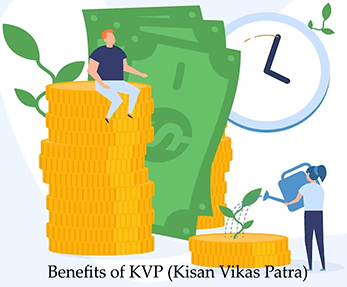
- Government Backing: KVP is backed by the Government of India, ensuring security for investors.
- Assured Returns: Investors can rely on KVP for guaranteed returns, providing a fixed rate of interest on their investment.
- Long-Term Focus: KVP promotes long-term savings, maturing over a period of 2.5 to 10 years, depending on the chosen scheme.
- Unlimited Investment: There’s no maximum investment limit in KVP, enabling investors to contribute according to their financial capabilities.
- Tax Consideration: While KVP doesn’t offer tax benefits like Section 80C deductions, the interest earned is taxable. However, the initial investment amount remains tax-exempt.
- Flexibility in Investment: KVP allows partial withdrawals after the lock-in period, providing investors with some liquidity if required.
- KVP certificates are available at India Post Offices and selected public sector banks, ensuring easy accessibility for investors nationwide.
- Investors have the option to nominate a beneficiary for their KVP investment, ensuring smooth transfer of proceeds to the nominee in case of the investor’s demise.
- KVP certificates are transferable between individuals, providing flexibility in ownership transfer if required.
- Unlike certain other investment options, KVP does not mandate a demat account, simplifying the investment process for individuals.
How to open KVP (Kisan Vikas Patra) account?
Kisan Vikas Patra (KVP) is a financial program designed to promote the habit of saving and investing for the future, particularly over the long term. You can get KVP certificates at India Post Offices and selected public sector banks. You can even find the KVP application forms online.
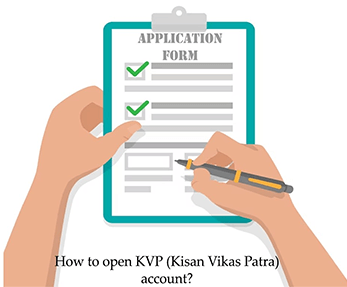
Starting a KVP account is a straightforward procedure, comprising four uncomplicated steps.
- Collect the Form A application form from the post office or bank and fill it out with the necessary information. Make sure to sign it.
- When completing the application, please include essential documents to confirm your identity. These may include your Aadhaar Card, PAN Card, Driver’s License, or Voter ID. Also, provide address proof like Passport, Electricity Bill, Water Bill, or Bank statement for KYC verification.
- Once your documents have been confirmed, you’re eligible to begin depositing funds into your KVP account. You have the option to deposit cash, cheques, or demand drafts payable to the “Post Master General.”
- After completing the payment, your KVP certificate will be dispatched to you via mail. Remember to safeguard it as you’ll require it for future investment withdrawals. Alternatively, if you prefer receiving the certificate via email, you can simply instruct them accordingly.
Who is eligible for KVP (Kisan Vikas Patra)?
Kisan Vikas Patra (KVP) is a savings certificate scheme offered by the India Post Office. Its main purpose is to help people double their investments over a fixed period of 138 months.
The scheme encourages long-term savings and is suitable for those who prefer low-risk investments, have extra funds, and want guaranteed returns.
If you’re seeking ways to save on taxes, various options are available. These include investing in instruments such as the Public Provident Fund (PPF), National Savings Certificates (NSC), Fixed Deposits (FDs), or the Equity Linked Savings Scheme (ELSS), which offers potential returns alongside a certain degree of risk.
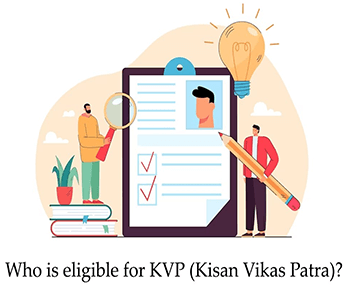
Originally, the Kisan Vikas Patra (KVP) scheme was exclusively offered to farmers. However, it has since expanded its accessibility to the general public, albeit with a few exemptions. To participate in the KVP savings scheme, certain eligibility criteria must be met.
- To qualify, you need to be both an adult and a resident of India.
- Adults responsible for children can make investments in the name of those minors.
- Non-Resident Indians (NRIs) and Hindu Undivided Families (HUFs) are not allowed to invest in Kisan Vikas Patra.
- Trusts can purchase KVP certificates.
What is the process for withdrawing funds from a Kisan Vikas Patra (KVP) account upon maturity?
The Kisan Vikas Patra (KVP) stands as a savings scheme brought forth by the Government of India, catering to individuals inclined towards low-risk investment avenues. Offered in the form of certificates akin to fixed deposit receipts, KVP can be acquired from designated banks or India Post outlets.
In India, any adult citizen residing within the country has the eligibility to purchase Kisan Vikas Patra (KVP) either under their own name or on behalf of a minor. Additionally, joint ownership is permissible. KVP certificates come in two distinct types.
- Joint A Type Certificate: This certificate is issued to two adults, and the payment can be made to either both holders together or to their heir.
- Joint B Type Certificate: Issued jointly to two adults, and the amount is payable to either of the holders jointly or their heir.
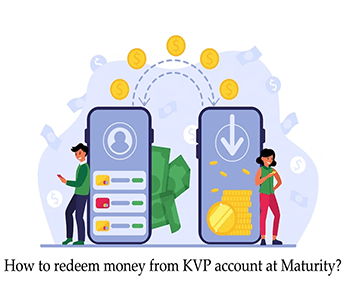
Trusts also have the opportunity to invest in Kisan Vikas Patra (KVP).
After the KVP matures, both the principal amount and the accrued interest will be deposited into your savings bank account. It should be emphasized that the interest gained is liable to be taxed. Upon maturity of the certificate, specific documents must be provided.
- Original KVP certificate.
- Identity proof of the certificate holder.
Upon receiving the redeemed amount, the investor or their representative is required to endorse the back of the KVP certificate. When a minor KVP holder comes of age, they must personally sign the certificate, accompanied by either the authentication of a familiar individual or certification from the Post Master.
Transfer of KVP (Kisan Vikas Patra) Certificate
You can obtain the Kisan Vikas Patra (KVP) application form at any post office or designated banks. This scheme permits the transfer of certificates between individuals and from one post office or bank branch to another.
In order to transfer ownership of a KVP certificate, certain documents are required.
- Identity Proof: Aadhaar Card, Driving License, Voter ID, Passport, etc.
- Residence Proof: Aadhaar Card, Driving License, Voter ID, Telephone Bill, Passport, etc.
- Original Kisan Vikas Patra (KVP) Certificate
- PAN Card Copy
To transfer the KVP certificate from one post office to another, you can fill out a form provided by the Post’s Director General at either of the post offices. In the case of a joint certificate, the transfer requires approval from both owners. Should one owner decease, the remaining owner will be responsible for completing the transfer process.
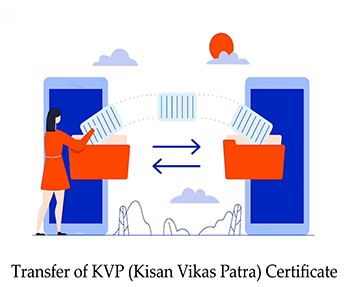
To initiate the transfer of a KVP certificate to another individual, specific conditions must be satisfied.
- Approval from both the Head Postmaster and Sub Postmaster is required if the transfer is within the same post office where the certificate was originally issued.
- A corporation has the authority to assign a Kisan Vikas Patra (KVP) certificate to the employee for whom it was originally procured.
- The transfer can be done from a Cooperative Financial Institution, Planned Financial Institution, or Reserve Bank of India to its member or customer.
- The certificate is transferable either to the court of law or to an individual appointed by the court.
- The ownership rights can be passed from a deceased individual to their rightful inheritor or legal successor.
- Ownership can transition from a solitary proprietor to several co-owners.
- It can be transferred from joint owners to a single person from the joint owners or to the remaining owner.
KVP (Kisan Vikas Patra) premature closure/early withdrawal
The Kisan Vikas Patra (KVP) is a savings scheme supported by the Indian Government. You can invest in this scheme at post offices all over India. When you opt for Kisan Vikas Patra (KVP) investment, you’re issued a personalized certificate. This investment scheme promises attractive returns by accruing interest at a significant rate over a fixed duration.
You also have the option to prematurely terminate your KVP (Kisan Vikas Patra) before its designated maturity date. After 2 years and 6 months (30 months) from the date of issuance, which is the minimum lock-in period, you can withdraw the principal amount along with the interest.
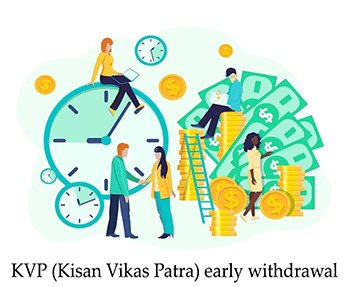
To close the KVP before maturity, you need to inform the Post Office in writing about your decision and the amount you will receive. You’re only permitted to redeem the KVP under two circumstances: upon the demise of the holder or upon issuance of court directives.
In certain circumstances, you have the opportunity to withdraw funds from the Kisan Vikas Patra before its maturity date.
- If ordered by a Court of law.
- In case of forfeiture by a pledge or by a Gazetted Officer.
- In situations where multiple individuals hold joint ownership, if one or more of the holders passes away, certain protocols are triggered.
To redeem your KVP certificate at a different post office, you must fulfill specific requirements. You’ll need to provide your identity slip, issued to you during the purchase of the KVP certificate. Draft a letter addressed to the relevant post office, enclosing your identity slip, to proceed with the encashment of your KVP certificate.
Disadvantages of KVP (Kisan Vikas Patra)
The Kisan Vikas Patra (KVP) scheme presents several drawbacks that warrant consideration:
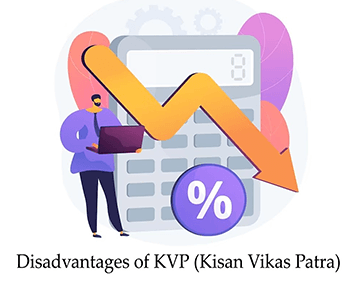
- Fixed Interest Rate: The interest rate for KVP remains constant, set by the government. This implies that if market interest rates increase, you won’t enjoy higher returns.
- Lack of Liquidity: KVP entails a lock-in period, restricting access to your funds during emergencies since you can’t withdraw your investment until the specified duration lapses.
- Taxation on Interest: The interest earned through KVP is subject to taxation, diminishing overall returns as taxes eat into your income.
- Inflation Risk: The fixed interest rate of KVP may not outpace inflation, leading to a decrease in purchasing power over time as inflation erodes the value of returns.
- Limited Investment Options: KVP stands as a singular investment avenue, potentially lacking diversification benefits. Exploring other investment options may better suit your financial objectives.
- Lack of Flexibility: Once invested in KVP, adjustments to the investment amount aren’t possible, restricting adaptability to changing financial circumstances.
- Non-availability of Online Investment: KVP purchases are limited to post offices and selected banks, inconveniencing those who prefer online transactions due to the absence of digital investment platforms.

